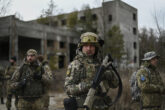January 06, 2025
Tehran’s Proxies Are on the Back Foot. An Iran-Russia Defense Pact Could Revive Them.
The sudden collapse of Bashar al-Assad’s government in December 2024 has led many to focus on Russia, and its inability or unwillingness to prioritize Syria due to the conflict in Ukraine. But focusing too much on Russia understates the role that Iran, and more specifically Tehran’s proxies, played in propping up Assad. After all, Russia has been at war for almost three years, but it was only when Hezbollah was preoccupied with its war against Israel and Iran was no longer willing to spare resources to prop up the failing dictator that Assad’s regime finally crumbled.
Under the proposed “comprehensive strategic partnership” between Moscow and Tehran, we are likely to see the Iran-Russia relationship strengthen over time, not just on a conventional level but in terms of Moscow’s support for Iran’s proxy forces. A renegotiated defense treaty is likely to result in Hamas, Hezbollah, the Houthis, and Iranian-backed Iraqi militias playing a more outsized role in the Iran-Russia relationship.
A renewed defense treaty between these two powers will render Iran’s web of proxies all the more dangerous by arming already destabilizing agents with more advanced weapons technology and the capacity to manufacture and ship arms to new battlefields.
With a renewed “all-encompassing” Iran-Russia defense agreement, Iran is likely to budget more funds for its overseas proxies and increase weapons shipments, creating new opportunities for Russia to tap sources of black-market weapons and skirt sanctions. Russia has started doing this already on a small scale; in March and April 2022, Iran-backed Hashd al-Sha’bi militants shipped Iranian rocket-propelled grenades (RPGs), anti-tank missiles, and Brazilian Astros II rocket launchers to Russia by sea, which were later used in Ukraine.
The reverse flow of weapons also exists. Less than a month after Hamas’s horrific Oct. 7, 2023, assault on Israel, CNN and The Wall Street Journal reported that Syrian President Bashar al-Assad agreed to send Hezbollah the SA-22 missile system — an advanced Russian anti-aircraft weapon — via Russia’s state-sponsored mercenary Wagner Group. While officials never confirmed whether Wagner completed the delivery, the IDF later released photo evidence of other “state-of-the-art” Russian missiles stored in Hezbollah weapons caches, smuggled over-land into Lebanon via Syria. According to an unnamed Israeli major cited by The Wall Street Journal, Russian weapons alone constituted an estimated 60 percent to 70 percent of the Hezbollah weapons confiscated by the IDF in the first few days of the 2024 Israeli ground operation in southern Lebanon, prompting major concerns about Russian-Iranian weapons proliferation to proxy militias.
Read the full article on Breaking Defense.
More from CNAS
-
Ukraine Negotiations: Prospects and Pitfalls of Peace
This week Brussels Sprouts breaks down the latest negotiations on Ukraine. American officials told reporters that they had resolved or closed gaps around 90 percent of their d...
By Andrea Kendall-Taylor & Jim Townsend
-
Transatlantic Security / Middle East Security
The Russia-Iran Partnership: A Geopolitical Balancing ActIt has been almost a year since Russia and Iran signed their comprehensive strategic partnership. That deal established a 20-year partnership between the two countries coverin...
By Andrea Kendall-Taylor & Jim Townsend
-
Defense / Transatlantic Security
Ukraine’s Catch-22 MomentThis article was originally published in the Financial Times. In Joseph Heller’s wartime classic, Catch-22, the protagonist Yossarian seeks out the US army surgeon Doc Daneeka...
By Franz-Stefan Gady
-
Transatlantic Security / Middle East Security / Energy, Economics & Security
Sanctions Aren’t Enough to Shut Down the Moscow-Tehran Black Market for WarThe geographic scope and extent of Iranian-Russian cooperation highlights the failure of traditional sanctions to prevent Moscow and Tehran from seeking key components like ch...
By Delaney Soliday




